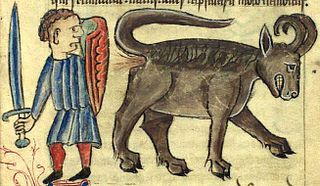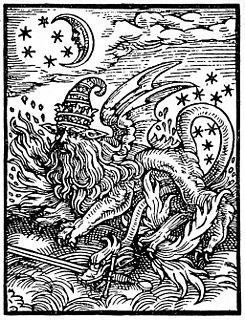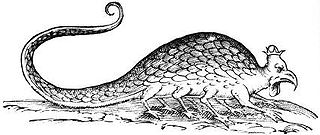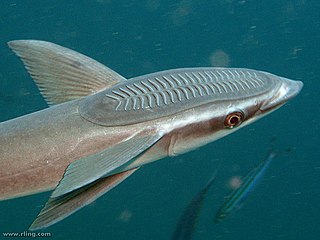Related Research Articles

A bestiary, or bestiarum vocabulum, is a compendium of beasts. Originating in the ancient world, bestiaries were made popular in the Middle Ages in illustrated volumes that described various animals and even rocks. The natural history and illustration of each beast was usually accompanied by a moral lesson. This reflected the belief that the world itself was the Word of God, and that every living thing had its own special meaning. For example, the pelican, which was believed to tear open its breast to bring its young to life with its own blood, was a living representation of Jesus. The bestiary, then, is also a reference to the symbolic language of animals in Western Christian art and literature.
Pliny may refer to:

The unicorn is a legendary creature that has been described since antiquity as a beast with a single large, pointed, spiraling horn projecting from its forehead. The unicorn was depicted in ancient seals of the Indus Valley Civilization and was mentioned by the ancient Greeks in accounts of natural history by various writers, including Ctesias, Strabo, Pliny the Younger, Aelian and Cosmas Indicopleustes. The Bible also describes an animal, the re'em, which some versions translate as unicorn.

Gaius Plinius Secundus, called Pliny the Elder, was a Roman author, a naturalist and natural philosopher, a naval and army commander of the early Roman Empire, and a friend of emperor Vespasian. He wrote the encyclopedic Naturalis Historia, which became an editorial model for encyclopedias. He spent most of his spare time studying, writing, and investigating natural and geographic phenomena in the field.

Pannonia was a province of the Roman Empire bounded on the north and east by the Danube, coterminous westward with Noricum and upper Italy, and southward with Dalmatia and upper Moesia. Pannonia was located in the territory of present-day western Hungary, eastern Austria, northern Croatia, north-western Serbia, northern Slovenia and northern Bosnia and Herzegovina.

The Chauci were an ancient Germanic tribe living in the low-lying region between the Rivers Ems and Elbe, on both sides of the Weser and ranging as far inland as the upper Weser. Along the coast they lived on artificial mounds called terpen, built high enough to remain dry during the highest tide. A dense population of Chauci lived further inland, and they are presumed to have lived in a manner similar to the lives of the other Germanic peoples of the region.

The remoras, sometimes called suckerfish, are a family (Echeneidae) of ray-finned fish in the order Carangiformes. Depending on species, they grow to 30–110 cm (12–43 in) long. Their distinctive first dorsal fins take the form of a modified oval, sucker-like organ with slat-like structures that open and close to create suction and take a firm hold against the skin of larger marine animals. The disk is made up of stout, flexible membranes that can be raised and lowered to generate suction. By sliding backward, the remora can increase the suction, or it can release itself by swimming forward. Remoras sometimes attach to small boats, and have been observed attaching to divers as well. They swim well on their own, with a sinuous, or curved, motion.

The bonnacon is a legendary creature described as a bull with inward-curving horns and a horse-like mane. Medieval bestiaries usually depict its fur as reddish-brown or black. Because its horns were useless for self-defense, the bonnacon was said to expel large amounts of caustic feces from its anus at its pursuers, burning them and thereby ensuring its escape.

The crocotta or corocotta, crocuta, or leucrocotta, is a mythical dog-wolf of India or Ethiopia, linked to the hyena and said to be a deadly enemy of men and dogs.

The Frisii were an ancient Germanic tribe living in the low-lying region between the Rhine–Meuse–Scheldt delta and the River Ems, and the presumed or possible ancestors of the modern-day ethnic Frisians.

The salamander is an amphibian of the order Urodela which, as with many real creatures, often has been ascribed fantastic and sometimes occult qualities by pre-modern authors not possessed by the real organism. The legendary salamander is often depicted as a typical salamander in shape with a lizard-like form, but is usually ascribed an affinity with fire, sometimes specifically elemental fire.

The Panotti were a mythical race of people, described as possessing large ears that covered their entire bodies.
The idea that there are specific marine counterparts to land creatures, inherited from the writers on natural history in Antiquity, was firmly believed in Islam and in Medieval Europe. It is exemplified by the creatures represented in the medieval animal encyclopedias called bestiaries, and in the parallels drawn in the moralising attributes attached to each. "The creation was a mathematical diagram drawn in parallel lines," T. H. White said a propos the bestiary he translated. "Things did not only have a moral they often had physical counterparts in other strata. There was a horse in the land and a sea-horse in the sea. For that matter there was probably a Pegasus in heaven". The idea of perfect analogies in the fauna of land and sea was considered part of the perfect symmetry of the Creator's plan, offered as the "book of nature" to mankind, for which a text could be found in Job:
But ask the animals, and they will teach you, or the birds of the air, and they will tell you; or speak to the earth, and it will teach you, or let the fish of the sea inform you. Which of all these does not know that the hand of the Lord has done this? In his hand is the life of every creature and the breath of all mankind.

Hercinia is a legendary bird with glowing feathers that inhabited the Hercynian Forest of ancient Germany.

A pard is a legendary animal that is listed in Medieval bestiaries and in Pliny the Elder's book Natural History. Over the years, there have been many different depictions of the creature including some adaptations with and without manes and some in later years with shorter tails. However, one consistent representation shows them as large felines often with spots.

In European bestiaries and legends, a basilisk is a legendary reptile reputed to be a serpent king, who can cause death with a single glance. According to the Naturalis Historia of Pliny the Elder, the basilisk of Cyrene is a small snake, "being not more than twelve fingers in length", that is so venomous, it leaves a wide trail of deadly venom in its wake, and its gaze is likewise lethal. Its weakness is the odor of the weasel and the tears of a griffin, which, according to Pliny, was thrown into the basilisk's hole, recognizable because some of the surrounding shrubs and grass had been scorched by its presence. It is possible that the legend of the basilisk and its association with the weasel in Europe was inspired by accounts of certain species of Asiatic snakes and their natural predator, the mongoose.

Echeneis is a genus of fish in the family Echeneidae, the remoras. The genus is distributed in the Atlantic, Pacific and Indian Oceans.

The live sharksucker or slender sharksucker is a species of marine fish in the family Echeneidae, the remoras.

The whitefin sharksucker or short-disk sharksucker, is a species of remora native to subtropical waters of the western Atlantic Ocean, Gulf of Mexico and Caribbean Sea. This fish can reach a length of 75 centimetres (30 in) TL though most fish do not exceed 50 centimetres (20 in) TL. It can be free-swimming, or can attach itself to a host fish or turtle by means of a sucker on the back of the head.
References
- ↑ Pliny Natural History 9.41
- 1 2 Echeneis at the Medieval Bestiary. Accessed 28 February 2016
- ↑ Gudger, E. W. (1918). "The myth of the ship-holder: studies in Echeneis or Remora". The Annals and Magazine of Natural History: Including Zoology, Botany, and Geology.